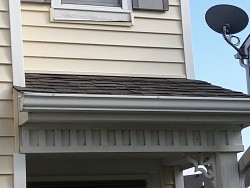Rooftop Rainwater: Harvesting & Collecting

Rooftop rainwater harvesting is a fancy term for collecting rain water from roof runoff. It is a great way to keep rain water from spilling onto sidewalks and driveways or unnecessarily soaking a small patch of the yard. It can reduce water bills and help the environment by efficiently using rain water instead of fresh drinking water from your home plumbing system for irrigation.
There are two main methods of rooftop rainwater harvesting: 1) collecting rain water from roof runoff with a rain barrel or 2) creating a trench garden that weaves through the yard.
Rooftop Rainwater Harvesting with a Barrel
It’s easy to start collecting rainwater from roof and gutter runoff with a homemade or commercial barrel. The cheapest method of rooftop rainwater harvesting is customizing a large garbage can or plastic drum. Sturdy commercial alternatives are widely available for about $100. Many have holes in the top for collecting rain water from roof runoff, and a spigot on the bottom for filling watering cans or attaching hoses.
Protect against health dangers related to rooftop rainwater harvesting with a barrel. Use only opaque barrels to prevent algae growth. Also, cover the top and seal around the spigot to avoid breeding mosquitoes.
Rooftop Rainwater Harvesting with Smart Landscaping
More complex rooftop rainwater harvesting systems involve digging shallow, wide channels through the yard. Most flowers and other plants should be planted in these channels. Properly collecting rain water from roof runoff and channeling it through the yard may require a professional landscape designer, who'll typically design the channels at least three inches deep, with a downward slope. In dry areas, designs for these rooftop rainwater harvesting systems should apply xeriscape principles, mulching the surface and using low-water native plants.
Rooftop Rainwater Harvesting Laws
Collecting rain water from roof runoff in barrels is illegal in Colorado and Utah because of complex water laws. Conversely, some Arizona and New Mexico cities require rooftop rainwater harvesting for some new construction.
Rooftop rainwater harvesting has environmental and financial benefits. It can reduce water bills and save municipalities the cost of treating freshwater that would be used to irrigate your lawn. Collecting rainwater from roof runoff also reduces erosion and evaporation, and can keep fertilizers and pesticides out of streams and groundwater.
Updated December 11, 2018.
Related Articles
Looking for a Pro? Call us (866) 441-6648

Roofing Average Costs
Roofers Experiences

Garage Roof Replacement Increases Curb Appeal Of A House For Sale

Shingle Replacement Stops My Roof Leak Before A Severe Rainstorm



